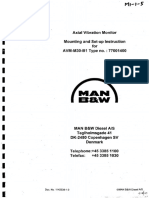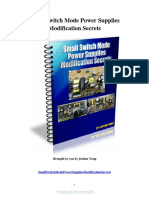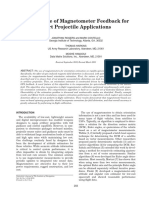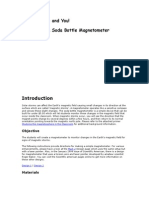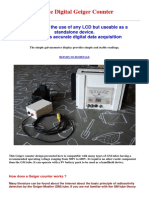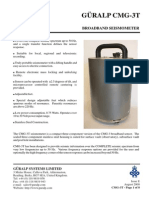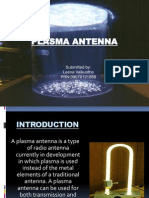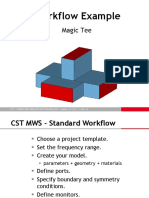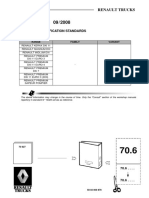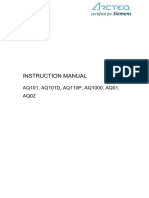0 ratings0% found this document useful (0 votes)
190 viewsPracticalBuildingGuidelines1 2
PracticalBuildingGuidelines1 2
Uploaded by
imarianroThis document provides guidelines for hobbyists to build a simple magnetometer. It outlines three cases for builders based on their skills: those without skills can only buy commercial units; those with manual skills but limited electronics design skills can build a simple differential gradiometer using fluxgate or proton precession magnetometer sensors; and those wanting to experiment can start by building three basic modules - a simple solenoid sensor, polarization control, and low-noise preamplifier - to learn fundamentals before expanding the design. Proper testing equipment is also discussed, including a multimeter, function generator, and audio spectrum analyzer or alternative software.
Copyright:
Attribution Non-Commercial (BY-NC)
Available Formats
Download as PDF, TXT or read online from Scribd
PracticalBuildingGuidelines1 2
PracticalBuildingGuidelines1 2
Uploaded by
imarianro0 ratings0% found this document useful (0 votes)
190 views0 pagesThis document provides guidelines for hobbyists to build a simple magnetometer. It outlines three cases for builders based on their skills: those without skills can only buy commercial units; those with manual skills but limited electronics design skills can build a simple differential gradiometer using fluxgate or proton precession magnetometer sensors; and those wanting to experiment can start by building three basic modules - a simple solenoid sensor, polarization control, and low-noise preamplifier - to learn fundamentals before expanding the design. Proper testing equipment is also discussed, including a multimeter, function generator, and audio spectrum analyzer or alternative software.
Original Description:
th
Original Title
PracticalBuildingGuidelines1-2
Copyright
© Attribution Non-Commercial (BY-NC)
Available Formats
PDF, TXT or read online from Scribd
Share this document
Did you find this document useful?
Is this content inappropriate?
This document provides guidelines for hobbyists to build a simple magnetometer. It outlines three cases for builders based on their skills: those without skills can only buy commercial units; those with manual skills but limited electronics design skills can build a simple differential gradiometer using fluxgate or proton precession magnetometer sensors; and those wanting to experiment can start by building three basic modules - a simple solenoid sensor, polarization control, and low-noise preamplifier - to learn fundamentals before expanding the design. Proper testing equipment is also discussed, including a multimeter, function generator, and audio spectrum analyzer or alternative software.
Copyright:
Attribution Non-Commercial (BY-NC)
Available Formats
Download as PDF, TXT or read online from Scribd
Download as pdf or txt
0 ratings0% found this document useful (0 votes)
190 views0 pagesPracticalBuildingGuidelines1 2
PracticalBuildingGuidelines1 2
Uploaded by
imarianroThis document provides guidelines for hobbyists to build a simple magnetometer. It outlines three cases for builders based on their skills: those without skills can only buy commercial units; those with manual skills but limited electronics design skills can build a simple differential gradiometer using fluxgate or proton precession magnetometer sensors; and those wanting to experiment can start by building three basic modules - a simple solenoid sensor, polarization control, and low-noise preamplifier - to learn fundamentals before expanding the design. Proper testing equipment is also discussed, including a multimeter, function generator, and audio spectrum analyzer or alternative software.
Copyright:
Attribution Non-Commercial (BY-NC)
Available Formats
Download as PDF, TXT or read online from Scribd
Download as pdf or txt
You are on page 1of 0
Practical Guidelines for building a Magnetometer by Hobbyists
Part 2 : Practical Building Guidelines
Practical Guidelines for building a Magnetometer by Hobbyists
Part 2:Practical Building Guidelines
W. Bayot
Version 1.2
17 November 2007
Practical Guidelines for building a Magnetometer by Hobbyists .................................................................. 1
Part 2:Practical Building Guidelines.............................................................................................................. 1
1. Introduction ........................................................................................................................................... 2
1.1. Building a simple Solenoid Sensor ..................................................................................4
1.1.1. Coil made resonant?........................................................................................................5
1.1.2. Adjusting a resonant coil..................................................................................................6
2. Power Supply module........................................................................................................................... 7
3. Polarization Control sub-system........................................................................................................... 9
3.1. Building............................................................................................................................9
3.2. Testing...........................................................................................................................10
4. Audio Amplification Chain................................................................................................................... 12
4.1. PRE-AMPLIFIER STAGE..............................................................................................12
4.1.1. PRE-AMPLIFIER TESTING...........................................................................................14
4.1.2. TESTING PRE-AMP WITH SENSOR ...........................................................................14
4.2. TUNED AMPLIFIER STAGE .........................................................................................15
4.3. ANALOGUE OUTPUT STAGE......................................................................................16
4.3.1. TESTING FULL AMPLIFIER CHAIN WITH SENSOR...................................................16
5. Polarization/Relaxation cycle testing .................................................................................................. 17
5.1. Test procedure...............................................................................................................17
5.2. Whats next?..................................................................................................................18
6. Signal Post-processing and Display sub-systems.............................................................................. 19
6.1. DIGITAL OUTPUT STAGE............................................................................................19
6.2. MODULE TESTING.......................................................................................................19
6.3. DIGITAL ANALYSIS......................................................................................................20
6.4. STORAGE AND DISPLAY ............................................................................................20
20/11/07 1
Practical Guidelines for building a Magnetometer by Hobbyists
2
1. Introduction
Now that you have had the opportunity to read an analytical view over the mysteries of magnetism and
proton behavior applied to Magnetometers, we can gather all that accumulated knowledge to start building a
real one.
The first decision you will have to take depends both on your electronic skills and the purpose of such a
project.
Case 1. Not much manual skills
In this case, you probably do not fit in this scenario. If you absolutely require a mag to be used in any
particular application, you should go to the ready-to-run (but rather expensive) commercial product lines.
Case 2. Good manual skills but no or few electronic design skills
This is the least you need to envision a simple mag project.
Here, you need to decide whether you will be happy to build a simple but rather crude operational system and
use it ASAP or if you just want first to experiment with the PPM technology itself with or without any end result
as operational instrument.
Case 2.1. Build-and-Use
In that case, you could choose to build a differential magnetometer (or rather, an analogue gradiometer).
This system is very easy to build, to test and to operate and it will give you its results in real-time. Your ears
will be the main instruments to detect potential ferromagnetic targets of a certain volume.
This system can be made based on one of two possible sensor types: Fluxgate and Proton Precession.
However, as such, this system will not have a fantastic sensitivity; the best you should expect is to detect
gradients of at least 15 to 25 nT.
There is a Fluxgate Gradiometer Project description in the Carls MAG site. It is based on ready-made
sensors and accessory electronic chips that you can buy from a producer in UK or a representative in US
for around 150 bucks. Carl has also provided a ready-made PCB layout. I know that he has built it a few
years ago and it was working according to its (limited) specs. The mechanical mounting and adjusting of
the Fluxgate sensors are a bit critical for the good functioning of the system but there is nothing a DIY can
not do. I have heard from Carl that this project could still be improved in sensitivity but I still do not know
how.
A simple differential PPM is fully described in a CD sold by Phil Barnes. The necessary material to build
this one can be found everywhere and would cost a few tens of bucks. It is mounted on a prototype board,
so no PCB making is involved in the building. If the building is strictly made according to the instructions
and schemas, there should also not any problem in the testing. However, applying the step-by-step
testing procedures described further on in this paper will help to know better your system and to discover
any possible flaws. This system can also be used as a test platform for those who still want to experiment
with different sensor specs.
Case 2.2. Experiment and Learn (possibly use it later on the field)
There are a multitude of experiments that can be made with PPMs. As soon as a few functional modules
have been built and tested, a lot of possible options can be tried (sensors, polarization control, low noise pre-
amp, signal processing, mechanical arrangements,...)
The very first (and most critical) modules are:
1. Sensor: In our step-by-step procedures, we shall start with the simplest-to-build sensor type: a double coil
solenoid sensor closely wound around a single bottle full of distilled water, one of the easiest proton-rich
fluids to deal with. It is non-aggressive and has a long relaxation time. However, other fluids should be
attempted later on because water freezes and requires a rather long polarization time (thus, consume
much battery energy) to acquire its full activity.
2. Polarization Control module: This module could be implemented very simply but it needs to respect a
minimum set of conditions. The triggering of the polarization and its end could be entirely controlled by
hand or it could be put under control of a micro-controller for the timing adjustment. We shall start with a
rather simple relay-based switching and will continue with a sophisticated solid-state switching system
giving all guarantees of a perfect switching ON and OFF of the polarization current.
3. Low Noise Pre-Amplifier: The tiny captured sine wave signal(at V level) will be amplified keeping as
much as possible its original shape without adding spurious noise.
20/11/07
2
Practical Guidelines for building a Magnetometer by Hobbyists 3
With only these modules and a few simple tools, we shall already be able to experiment and learn many
important facts about this technology. The following tools are invaluable to this task:
1. DMM
with RMS Voltage (beware if the AC mode gives you an Effective V
p
or an RMS = V
p
/1.4142 value),
Frequency, Capacitance and, possibly, but not mandatory, Inductance measurements
2. AF or Function Generator
This need not be sophisticated, it has just to cover the lower audio frequencies (0.5 KHz to 5 KHz) and
generate sine wave signal with an adjustable RMS magnitude. If you do not have one, it is also possible to
use the Spectrum Analyzer Program described here after.
3. Audio Spectrum Analyzer
The audio Spectrum Analyzer is the most important instrument for the testing and experimentation of a mag.
If you have access to a true digital scope; its obviously OK since they always have this function included.
But, it can also be a PC-based scope with or without an external electronic box.
If you, poor man, have no access to any of those specialized instruments, dont worry, you can also use a
pure software PC package available free on the net there. It has been written and improved over several
years by a bunch of smart radio-amateurs.
It will give great satisfactions provided you run it alone on any modern desktop or laptop of reasonable CPU
power.
Before using it for good, you should better exercise yourself with its main operations since, although free, it is
a smart and sophisticated piece of software.
CALIBRATING THE SPECTRUM ANALYZER
Make a 1000/1 attenuator (resistance bridge e.g. 1 Mohm/1 Kohm)
Connect a Spectrum Analyzer adjusted to the audio band to the low side of the bridge.
Connect an AF/FUNCTION Generator to the high side of the bridge.
Adjust the generator to a sine wave signal of around 1V RMS @ 2 kHz
Set the vertical scale of the spectrum analyzer to mV.
Calibrate the vertical scale to measure an FFT peak of exactly 1 mV
4. WAVE File Editor
There are many, many programs like that available free on the net but this is the multi-platform one I am
personally using with satisfaction (still a few bugs left but nothing catastrophic)
5. An Analog or Digital Time-Domain Scope can be of help as well but not absolutely necessary in my
opinion for this particular project.
20/11/07
3
Practical Guidelines for building a Magnetometer by Hobbyists 4
1.1. Building a simple Solenoid Sensor
The specs of a sensor depend on its required practical application:
Large Underwater Target Search from a boat which can provide all the required energy
o Big coil (more turns of thicker wire), lots of fluid, to get a better signal
o With a higher signal, no need of resonant coil circuit.
Underground Target or Structure Search with limited weight battery backpacking
o Smaller, less energy-eating coil Less signal Resonant coil circuit recommended.
A standard sensor for starting your first experimentations and tests, although not the best in the world, is
described hereunder:
1. Look for a 100ml polythene or glass bottle with a cylindrical length of around 100mm and a diameter
of around 60mm.
2. You can choose between winding the coil directly on the bottle (if in plastic, fill it completely first) or
on a cylindrical form fitting the diameter of the bottle .
3. Make two pairs of two round sides with thick board or any equivalent material and glue them on the
form or on the bottle spaced of around 45mm. The two middle sides are separated by 10mm.
4. Use the Excel program provided by Jim Koehler HERE to calculate the expected signal magnitude
and its S/N ratio playing with the number of turns, current for a default fluid of WATER and a
polarization voltage of 12V. Select a wire gauge that you can easily buy. You should try to get at least
a signal of 1V and an S/N ration of 100.
For example, a solenoid sensor built around this type of bottle and wound with 1130 turns of 20 AWG
wire would give the following results:
Inductance = 57mH
DC resistance = 8.3 Ohms
Polarization Current = 1.46 Amps
Signal = 1.6 V RMS
S/N ration = 172 for a relatively wide bandwidth of 500Hz
It would need a resonant cap of around 108nF for a nominal frequency of 2030Hz.
There is also an interesting Excel program here. From the definition of the Voltage appiled on each
coil of the sensor and its dimension, it plots the variations of the expected signal magnitude, Current,
SNR, Weight and inductance giving the optimized number of wire layers to be wound.
This is the procedure in details:
1. In the common parameters sheet, select a Voltage which will be applied to each of the two coils. (=
half the total voltage)
2. In the common parameters sheet, define the diameter and length of the bottle in mm
3. Define a maximum weight
4. Look at each AWG sheet (starting with the thicker wire) and locate the line of your maximum
weight. If the corresponding current is reasonable enough, select this wire and wind that number of
layers of that wire. Otherwise, take the next AWG sheet.
Example for a bottle of 90mm long of diameter 50mm and voltage = 6Volts (this is the specs of my
bottles)
A coil of pre-defined weight of 1 Kg gives a signal of around 0.7V.
With a wire AWG 14, we need more than 15Amps--> Too high
With a wire AWG 16, we need 6.5Amps--> Too high
With a wire AWG 18, we need 2.3Amps--> OK
Thus, we get an SNR of 136 with 9 layers of AWG18.
If we accept a pre-defined weight of 2 Kg for the same dimensions, each coil will give a signal of
around 1.1V.
With a wire AWG 14, we need more than 7Amps--> Too high
With a wire AWG 16, we need 3.2 Amps--> OK
Thus, we get an SNR of 241 with 11 layers of AWG16.
20/11/07
4
Practical Guidelines for building a Magnetometer by Hobbyists 5
We could as well define a maximum current as constraint and search for the best SNR with a
reasonable weight.
For example, given a constraint of maximum current of 1 Amp,
AWG 14 and AWG 16 are not applicable because the coils would be too heavy.
AWG 18 is good since it needs a weight of 2Kg with a maximized SNR of 143. With this solution as
base, we can still decide to slightly decrease the current (at the expense of the weight) or slightly
increase the current to make the coils a bit lighter. These changes would not vary the SNR too much
since its peak is so wide there.
If we want to reduce the battery energy, AWG 20 is also good with a lower weight of 0.8Kg but with a
lower SNR of 81.
5. Wind the two coils in opposite directions with half the turns each.
6. Fix them in epoxy or any special electrical varnish to protect them against humidity which would be
detrimental to the quality of the signal.
7. Connect them in series.
8. IMPORTANT NOTE: Do not use ANY ferromagnetic material to fix or to contain the sensor, use nylon
nuts and bolts only.
1.1.1. Coil made resonant?
+ -
Free Supplementary Gain Region-dependent Adjusting
Free Pass-Band Filtering Signal grows exponentially during 100
msec instead of immediately at its max.
magnitude, thus loosing some useful
signal duration for measurement
When to use it?
Sensor is small (for backpacking)
Used in same region for long time periods
Polarization Fluid is Water or Benzene (long relaxation time)
When to avoid it?
Sensor is big (underwater usage)
Kit or international product
Polarization Fluid is kerosene or alcohol or diesel fuel.
20/11/07
5
Practical Guidelines for building a Magnetometer by Hobbyists
6
1.1.2. Adjusting a resonant coil
Use any of the numerous WEB calculators to know the nominal earth magnetic field value in your
region.
Multiply this B value in nT by 0.04256 to get the corresponding precession frequency.
If you have an instrument to measure the inductance of the coil, measure its inductance in mH and
apply the following formula to evaluate the required capacitance in nF to make the LC circuit
resonant at center frequency F for a coil of inductance L in mH:
C = 10
9
/(0,03948 * F
2
* L)
and connect a sufficient number of standard value capacitors in parallel to build the required value
else you will have to start from scratch and start with a 50 nF Capacitor or so.
Slowly sweep the AF Frequency of the generator from 1 kHz to 5 kHz.
Evaluate the peak height during this sweeping process.
The natural LC resonance frequency is the one for which the peak is maximum.
If you had calculated a C value, the peak frequency should not be very far from the required result,
otherwise it is probably higher than the required one since its C component is only made of the
internal capacitance of the coil and its connecting wires added to the first 50 nF cap.
If the peak frequency is too high, you must increase the cap value by putting more caps in parallel,
otherwise, you must decrease the current value by removing an existing cap and choose its next
lower standard value.
20/11/07
6
Practical Guidelines for building a Magnetometer by Hobbyists
7
2. Power Supply module
It is important that the power supply for the analog part of the circuit be regulated separately from the supply
of the digital circuit.
This is two separate and simple examples of power supply circuits enough to feed a PPM. Do not hesitate to
replace them by your favorite circuit, if you wish. Except for the polarization which requires a lot of current
under the unregulated 12V, the rest of the circuit should only consume less than 100mA.
20/11/07
7
Practical Guidelines for building a Magnetometer by Hobbyists 8
20/11/07
8
Practical Guidelines for building a Magnetometer by Hobbyists
9
3. Polarization Control sub-system
3.1. Building
Lets now start with the polarization control circuit.
Here follows the list of Mandatory Specs for this module:
1. ON/OFF Current Switching without any contact bouncing
2. Polarization Current switch OFF (down to null) in less than 50 to 100sec
3. Very low Switch ON DC resistance (for main current, to avoid generating heat - for V level signal,
to avoid loosing any amplitude)
4. Pre-Amp Input protected from spikes; disconnected during polarization period
5. Pre-Amp Input re-connected to sensor a few msec after the end of polarization.
6. No spurious current (not even 1 nA) through coil during measurement period.
7. If Coil is made resonant, Caps should NOT be connected during polarization.
For the first experiments, you should select a manually-triggered polarization and relaxation cycle to
easily control the durations of the two phases.
The simplest system using a multi-circuit two-direction manual switch as in the Phil Barnes circuit
depends too much on the quality of switching of the manual device and could possibly not respect all the
above mandatory specs. I do not recommend building it except if you already have in your drawers a very
good switch like that.
A better variant is to use a relay with cold contacts (i.e. no current flowing during its switching transitions).
In this case, the main HOT switch is a power HEXFET whose gate can be triggered by a simple DC level
change or a simple push-button. This is the case of the easily found N-Channel HEXFET T1 in the
following figure but it can be replaced by an other N-channel device of equivalent parameters.
This device is also taking care of the snubbing (or anti-ringing) of the spikes due to the switching OFF of
the polarization current.
The HEXFET T1 takes care of the points 1,2,3 and 6 of the specs.
The relay takes care of the points 4,5 and 7 of the specs.
Thus, a complete cycle should start with a switch ON of the RELAY-CMD (disconnect pre-amp from coil,
connect the coil to T1 but still no current through the relay contacts) followed immediately with the switch
ON of the POLARIZE-CMD (starts DC current flowing in the coil), wait in that state for the duration of the
polarization, then switch OFF the POLARIZE-CMD, and, 20msec later, switch OFF of the RELAY-CMD.
At that moment, the signal measurement period can start.
For the preliminary tests and experimentations, the delay of 20msec between the two commands can
easily be implemented with a simple 555 Timer connected in one-shot or even a simple RC circuit with
appropriate values.
However, if you master any type of micro-controller technology, it would be a piece of cake to make the
complete switching control cycle with a small controller (it need not be fast) having a few digital I/O ports.
For such an application, I am personally using a PIC 12F675 or 12F629 from Microchip but I am sure that
there are a number of other choices.
For the real system, a micro-controller will take care of that with its digital control lines together with the
signal post-processing. We shall see this later on the paper.
20/11/07
9
Practical Guidelines for building a Magnetometer by Hobbyists 10
This second variant uses a main P-Channel HEXFET with a particularly low RDS(ON) and has a few
more interesting characteristics:
1. The two command lines could be controlled by any system with different power and ground
circuits and completely protects, through optocouplers, against any kind of digital noise circulating
between the two systems.
2. The auxiliary switching is made by a small two-direction REED relay which could even be easily
replaced by two small HEXFET to make a complete solid-state switching system.
(Note that if the IRF5210 can not be found, it can be replaced by the more usual IRFP9140)
A third, more sophisticated variant could be implemented according to the description of Jim Koehler at
page 46 of his paper. This variant will require a controller to execute the rather complex state changes.
3.2. Testing
Test first the switching cycles of your circuit without coil connected and check the voltage changes with
a DMM.
Then, put the coil in circuit and redo the test with measuring the DC current going through. It should
normally be at least 1 Amp. If you have a digital scope, its now the right time to check the quality of the
20/11/07
10
Practical Guidelines for building a Magnetometer by Hobbyists 11
switch ON and switch OFF voltage and current transitions. They should be as clean as possible to get the
best results on the quality of the signal.
20/11/07
11
Practical Guidelines for building a Magnetometer by Hobbyists
12
4. Audio Amplification Chain
4.1. PRE-AMPLIFIER STAGE
Simple Transistor with low noise collector currents of about 0.1 mA
Use metallic film resistances (lower noise)
Gain should be kept rather low for the first stage (V -->mV range = 1000 to 2000)
Possible second stage with low noise OpAmp.
Good Power Supplies decoupling and filtering
Ground Plane on PCB
PCB dimensions preferably long and narrow to keep output far away from input.
These are two different examples of proven low noise pre-amplifier stages using easy-to-find
components and a single voltage power supply.
The first circuit could be followed by the OpAmp stage of the second circuit (but based on an LM324)
to increase the total gain before the filtering stages.
20/11/07
12
Practical Guidelines for building a Magnetometer by Hobbyists 13
20/11/07
13
Practical Guidelines for building a Magnetometer by Hobbyists
14
4.1.1. PRE-AMPLIFIER TESTING
Check first the voltage of the power supply before inserting the OpAmp.
Make a 100000/1 voltage attenuator (resistance bridge e.g. 1 Mohm/10 ohm)
Connect the pre-amp to the low side of the bridge.
Connect a Spectrum Analyzer adjusted to the audio band to the output of the pre-amp.
Check level of noise with nominal input impedance only, it should be very low : -90 dB.
Connect an AF/FUNCTION Generator to the high side of the bridge.
Adjust the generator to a sine wave signal of around 100 mV RMS @ 2 kHz
The output signal magnitude will give you the gain of the pre-amp. You should observe a single,
clean, narrow FFT peak @ 2 kHz with an height of x mV on the vertical scale. The total gain
would then be 1000 * x.
The noise level should still be very low: max. -80 dB.
4.1.2. TESTING PRE-AMP WITH SENSOR
Remove the attenuator.
Connect the sensor (W/O any resonant circuit).
Wind a small auxiliary coil made of a few turns of thin wire with a 1K resistance in series to match
the output impedance of the generator.
Connect it to the AF/FUNCTION generator adjusted as a sine wave of 2 KHz
Set the vertical scale of the spectrum analyzer to mV instead of dB
Observe the amplitude of the FFT peak at the pre-amp output, adjust the amplitude of the
generator and/or modify the position of the auxiliary coil to get a peak of 1 to 2 mV.
The signal-to-noise ratio (SNR) should probably now be higher because the coil is now picking up
external electromagnetic disturbances and low frequency radio electric waves. (At this stage, it
could even be possible to hear some strange music from local radio emitters). The noise level
could now be around -40 dB.
20/11/07
14
Practical Guidelines for building a Magnetometer by Hobbyists
15
4.2. TUNED AMPLIFIER STAGE
A pass-band filtering stage is highly recommended to remove the too low and too high frequencies
after the first wideband pre-amp stages.
Usually, a bandwidth of 500 to 700Hz is enough to get rid of the spurious frequencies while still wide
enough to fit most of the occidental regions without re-adjustment. Its center frequency could be
around 2KHz.
There are a large number of active filter calculators on the web. I am personally using this one from
the site of Analog Devices: Active Filter Calculator
This is also a very convenient Excel Calculator for designing Multiple Feedback Bandpass Filters like
the one shown on the following figures.
Note that the bandwidth of the filter of this last example is rather wide: 1500Hz.
20/11/07
15
Practical Guidelines for building a Magnetometer by Hobbyists
16
4.3. ANALOGUE OUTPUT STAGE
This amplification stage is setting the final gain of the whole amplifier chain. It all depends on the
requirements of the signal post-processing.
If you want to feed an earphone for a differential mag, the gain should be enough to get to the 0.5 Volt
level.
If you want to feed a PC audio card to look at the final signal spectrum, a level of 10 to 100mV is more
than sufficient.
If you want to feed a digital output stage, a level of 1 to 10 mV is enough for a comparator to shape
square waves from the zero-crossings of the sine wave signal.
4.3.1. TESTING FULL AMPLIFIER CHAIN WITH SENSOR
Redo the procedure 4.1.2. on the whole chain.
20/11/07
16
Practical Guidelines for building a Magnetometer by Hobbyists
17
5. Polarization/Relaxation cycle testing
This is THE most critical turning point of this project. I should modestly acknowledge that it took me more
than one month of hard work and hit-and-misses before listening to the first true proton singing out of my
system.
Why did I take so much time? Because I did not know and meet ALL the conditions to get such a result.
I am now going to try to avoid the same trip for you.
As soon as the previous steps have been carefully executed, you are sure that your amplification chain and
your polarization circuit are working well.
IMPERIOUS CONDITION 1:
You ABSOLUTELY need to move the sensor coil away from any building and any electrical power line.
It means that you should put the sensor somewhere in your backyard or garden away from the street and from
the electrical supply of your house..
IMPERIOUS CONDITION 2:
The sensor SHOULD be put at least, at 50 to 100cm above the ground.
Since you probably want to make the following tests from the table of your lab, you could connect the sensor
to the electronics through a long, thick shielded cable. You can use 50 ohm LAN Coax or thick (low noise)
microphone cable.
IMPERIOUS CONDITION 3:
There should not be any switched-on AC-powered device closer than 5 meters to the electronic circuit
until it will be safely put in a shielded box. No PC, no neon light, no lab power supply.
It means that the results of the following tests should be captured by a laptop powered from its battery.
If you do not meet this condition, you will observe numerous permanent 50/60Hz harmonic peaks much bigger
than the temporary one of the signal.
5.1. Test procedure
When all conditions have been met, you could now start a 3 to 5 seconds polarization cycle. At the end
of this cycle, you should observe a growing and quickly decreasing FFT peak at around your nominal
precession frequency. The water fall display option of the spectrum analyzer will show this very clearly.
If you see it now, you have successfully executed most of the critical steps of the project. Use the
spectrum Analyzer to record the signal into a WAV file and analyze it in more details using a WAV file
editor.
Now, if you do not see anything but noise on all frequency bands, you should first carefully double-check
all the connecting circuits (and possibly redo the previous modular test steps) and verify that you have
met ALL the imperious conditions.
If you still do not see anything, there can be several possible reasons:
Check your battery, it could be that you do not get enough current out of it.
If you did not make a resonant coil, it could be that your total amplification gain is not enough. You
could try to increase the gain or to make your coil resonant.
It could be that the location of your sensor happens to be disturbed by an hidden strong source of
magnetic or electromagnetic noise. Move your sensor away to an other place which you feel safe
and retry.
If you see a continuous FFT peak without any decay, it means that your amplifier chain is oscillating. This
is an annoying case which often happen with high gain amplifiers. It really means that there az positive
feed-back between the last stages of the chain back to the first stage or to the sensor input. It could be
that reducing the total gain of the chain cure the problem but this is not sure. Otherwise, you must review
your component placement and ground plane.
20/11/07
17
Practical Guidelines for building a Magnetometer by Hobbyists 18
5.2. Whats next?
If you are at this point, you still not have a working PPM instrument but its main engine is there.
Now, what can you do?
You could build a second sensor identical to the first, connect them in series and in opposition, re-
tune the two together and mount them 1 or 2 meters apart. You package the electronic circuit in a
proper shielded box and you connect a quartz earphone to the analog output. Thus, you get a
rather good Differential Magnetometer. If you now put an iron or steel mass around the sensors
(closer to one and farther to the other), you will hear the characteristic amplitude beat generated
by the adding of two slightly different frequencies.
If you went this far, it would be a pity to stop here. There are now plenty of very interesting
experiments you can do with the already built modules. Since you now have a basic reference in
terms of Signal/Noise Ratio with your first simple sensor, you will try to optimize it. It is now time
to experiment with different types of sensors and different proton-rich fluids. You can
compare the captured WAV files and select the combination which is giving the best results. Note
that it is not yet time to worry about the frequency value of the signal but rather about its quality.
You still do not have the tools to precisely measure its frequency as the spectrum analyzer has
not enough resolution.
I consider that you should at least have an SNR of 40 to 50dB to have any chance to accurately
measure the frequency in the next steps of the procedure. If you get too much noise in the signal,
there will be spurious and missing period transitions giving more or less random results.
When you are happy with the quality (SNR) of the signal, so that its frequency can be measured,
then read the next chapter.
20/11/07
18
Practical Guidelines for building a Magnetometer by Hobbyists
19
6. Signal Post-processing and Display sub-systems
6.1. DIGITAL OUTPUT STAGE
The low level sine wave signal at the analog output needs now to be converted into a TTL-level square
wave digital stream to be fed into a micro-controller for its further processing and display.
This is two examples of comparator stage doing this task.
6.2. MODULE TESTING
Redo the procedure 4.1.2. on the whole chain. You should now get a continuous PCM stream at the
same magnitude (5 Volts). If you capture from this stream the part during which there was a sufficient
signal, you should see a main FFT peak at the same frequency as before but now, surrounded with a
large number of powerful harmonics due to the square wave shape of the digital signal.
20/11/07
19
Practical Guidelines for building a Magnetometer by Hobbyists 20
6.3. DIGITAL ANALYSIS
To accurately measure such a low frequency within such a small interval of time (max. 500 or 1000msec)
, it is not enough to just count the number of periods during this time. The best result would be a precision
of +- one period per second, which translates to only +- 23nT in magnetic field value.
The minimum required algorithm is to count an exact number of periods (as many as possible) starting a
few msec after the polarization phase and precisely time their total duration using a high speed timer. The
accuracy of the frequency measurement will only be depending on the timer. With a timer counting by
steps of 0.2sec, we could then get a precision of 0.01nT for the measurement of a single period.
However, since we measure the time of at least 512 consecutive signal periods, we could expect to get
even a much better precision.
I must repeat again that this accuracy is only correct for the calculation itself provided the counted periods
are right. If there were missing or supplementary zero-crossings due to a noise level being too high, the
end result would be much more degraded.
If you do not have a high speed timer, it may be wise to count and time 512 periods together and divide
the total time by 512 to get the average time of one period giving the frequency.
If you have a fast timer (> 1MHz), it would give a better result in terms of noise suppression if you capture
the cumulated timer value of each period and add it to a first large accumulator for the first 256 periods,
then do the same for the next 256 periods to a second large accumulator. Subtract the first from the
second accumulator and divide the result by 65536. This gives you the average time of one single period
with a much better accuracy.
If you are ready to go even further in the precision of the frequency measure, analyze this document and
implement its algorithm.
I shall not teach you in this paper how to design a micro-controller circuit as it is not its purpose. I suppose
that you either already master this technique or you could use any evaluation card delivered by all
manufacturers.
It is the same for the programming of those small beasts. The polarization switching logic and the
counter/timer handling are elementary programming tasks, even in Assembler. If you are a beginner in
that technology, you have a lot more to experiment there and, subsequently, a lot of fun.
The nT result of each measurement cycle should be stored in any kind of permanent memory like, for
example, a serial RAM or EEPROM waiting to be picked-up by a higher level display and storage system.
6.4. STORAGE AND DISPLAY
A magnetometer measuring the total earth field like the one you have built up to now is probably not
useable alone in the field.
The most usual and practical system configuration is a Gradiometer. As it was explained before, it is
made of TWO complete parallel single mag systems whose simultaneous measurements are digitally
subtracted to give a field gradient value which is the practical unit needed for 3D mapping surveys.
If you built you first system on some kind of breadboard for your first experiments, it is now time to design
and build a real PCB whose dimensions are calibrated to fit two of them in a proper shielded (copper or
aluminum) box. These will be the two slave cards controlled by a higher level control card.
This control system is a classical micro-controller card with its usual I/O devices like an LCD to display
gradient results in real-time, a few push-buttons to trigger the measurements, a large serial EEPROM to
store the results of the survey of the day and an RS232 link to upload these results to a PC for further
storage and 3D graphical color display.
20/11/07
20
Practical Guidelines for building a Magnetometer by Hobbyists 21
End of Document
20/11/07
21
You might also like
- Bose Lifestyle 28 Repair - Schematics PDFDocument32 pagesBose Lifestyle 28 Repair - Schematics PDFAurelio Machado80% (5)
- ACS2000 4kV Service ManualDocument133 pagesACS2000 4kV Service ManualWilliam Santhiago Vásquez RamosNo ratings yet
- Calibration of Loop Antennas For EMI Measurements in The Frequency Range Below 30 MHZDocument11 pagesCalibration of Loop Antennas For EMI Measurements in The Frequency Range Below 30 MHZAton Luan100% (1)
- Design Solutions For DC Bias of Multilayer Ceramic Capactiors (MLCCS)Document3 pagesDesign Solutions For DC Bias of Multilayer Ceramic Capactiors (MLCCS)Nikola DulgiarovNo ratings yet
- MPI Computing GuideDocument13 pagesMPI Computing GuideThilaga MohanNo ratings yet
- Chain MasterDocument60 pagesChain MasterBasilio Danzi50% (2)
- Axial Vibration MonitoringDocument29 pagesAxial Vibration MonitoringSolomon VargheseNo ratings yet
- Small Switch Mode Power Supplies Modification Secrets PDFDocument41 pagesSmall Switch Mode Power Supplies Modification Secrets PDFpedram93% (14)
- FGEFluxgateMagnetometerManual PDFDocument18 pagesFGEFluxgateMagnetometerManual PDFKhông Có GìNo ratings yet
- Digital Detection and Feedback Fluxgate MagnetometerDocument7 pagesDigital Detection and Feedback Fluxgate MagnetometerhsongunNo ratings yet
- Intermag 4-6Document100 pagesIntermag 4-6Chrstian DelgadoNo ratings yet
- Triaxial Digital Fluxgate MagnetometerDocument87 pagesTriaxial Digital Fluxgate MagnetometershansovNo ratings yet
- MAG3 SMT Datasheet RevD1Document4 pagesMAG3 SMT Datasheet RevD1lgrome73No ratings yet
- Earth Magnetometer ProjectDocument17 pagesEarth Magnetometer ProjectMario Ariel VesconiNo ratings yet
- Emad PHD ThesisDocument204 pagesEmad PHD Thesishazim_74No ratings yet
- Design and Development of A Fluxgate MagnetometerDocument5 pagesDesign and Development of A Fluxgate Magnetometerdr_oxide2No ratings yet
- Mag-01H Magnetic Inclination/Declination Magnetometer.Document8 pagesMag-01H Magnetic Inclination/Declination Magnetometer.sarveshchandraNo ratings yet
- Introduction To Magnetometer TechnologyDocument16 pagesIntroduction To Magnetometer TechnologymeeNo ratings yet
- Magnetic Surveying For Buried Metallic ObjectsDocument8 pagesMagnetic Surveying For Buried Metallic ObjectsV100% (4)
- IntroductiontoMagnetometerTechnology1 2Document0 pagesIntroductiontoMagnetometerTechnology1 2imarianroNo ratings yet
- Fluxgate Sensor Data Sheet - FMS 100Document2 pagesFluxgate Sensor Data Sheet - FMS 100JalalNo ratings yet
- Effective MagnetometerDocument17 pagesEffective MagnetometercartamenesNo ratings yet
- First Break MEGATEM StoryDocument5 pagesFirst Break MEGATEM StoryJasmin AgriNo ratings yet
- Construction of A Proton Magnetometer: Department of Physics, University of Colombo, Colombo 3Document8 pagesConstruction of A Proton Magnetometer: Department of Physics, University of Colombo, Colombo 3Yunus Emre VarlıNo ratings yet
- Advances in Fluxgate Sensors: Pavel RipkaDocument7 pagesAdvances in Fluxgate Sensors: Pavel RipkaJose AlaezNo ratings yet
- Radar Basics - MagnetronDocument3 pagesRadar Basics - MagnetronherrisutrisnaNo ratings yet
- Manual MagnetometerDocument5 pagesManual MagnetometerG Santosh BabuNo ratings yet
- MagnetometerDocument16 pagesMagnetometerButnariu CodrutNo ratings yet
- Magnetometer Offset NullingDocument4 pagesMagnetometer Offset Nullingr9hinoNo ratings yet
- AM NRSC Testing With The Loop Antenna (NRSC Bandwidth)Document5 pagesAM NRSC Testing With The Loop Antenna (NRSC Bandwidth)Rick Jordan100% (1)
- A Soda Bottle MagnetometerDocument5 pagesA Soda Bottle MagnetometerswarosNo ratings yet
- Basketware Sensor Detector - Koschey-5I/IMDocument6 pagesBasketware Sensor Detector - Koschey-5I/IMSneshko Snegic100% (1)
- Da 02 1658a1Document158 pagesDa 02 1658a1Anonymous YZ9Qb3YqwkNo ratings yet
- Arduino-UNO Based Magnetic Field Strength MeasurementDocument4 pagesArduino-UNO Based Magnetic Field Strength MeasurementIJIRSTNo ratings yet
- Huggard300magnetometer PDFDocument8 pagesHuggard300magnetometer PDFRichard PortillooNo ratings yet
- Magnetometers and Gadiometers PDFDocument21 pagesMagnetometers and Gadiometers PDFAndreea SavuNo ratings yet
- Eetop - CN ESD Simulation Talk 5-2-2 CST Ugm 2011Document17 pagesEetop - CN ESD Simulation Talk 5-2-2 CST Ugm 2011Văn CôngNo ratings yet
- (Synthesis Lectures On Algorithms and Software in Engineering 17) Michael Stanley, Jongmin Lee - Sensor Analysis For The Internet of Things-Morgan & Claypool Publishers (2018) PDFDocument139 pages(Synthesis Lectures On Algorithms and Software in Engineering 17) Michael Stanley, Jongmin Lee - Sensor Analysis For The Internet of Things-Morgan & Claypool Publishers (2018) PDFyogeeshNo ratings yet
- Assembling An HRPT SystemDocument5 pagesAssembling An HRPT Systembill_crews100% (1)
- Varactor Spice Models For RF VCO Aplications PDFDocument4 pagesVaractor Spice Models For RF VCO Aplications PDFZtrea PeniaNo ratings yet
- Simple Digital Geiger CounterDocument9 pagesSimple Digital Geiger CounterAnonymous Kti5jq5EJINo ratings yet
- Proton Precession MagnetometerDocument6 pagesProton Precession MagnetometerElza Anisa Suwandi IINo ratings yet
- Clarke1 300Document8 pagesClarke1 300Jo RoNo ratings yet
- 3T Broadband SeismometerDocument8 pages3T Broadband SeismometerSteveAbonyiNo ratings yet
- Photonic Crystal Cavities: Nanophotonics and Integrated OpticsDocument8 pagesPhotonic Crystal Cavities: Nanophotonics and Integrated OpticsMax Marcano CamposNo ratings yet
- Plasma AntennaDocument9 pagesPlasma Antennaleena999No ratings yet
- Multistage Coil Gun Project ProposalDocument8 pagesMultistage Coil Gun Project ProposalAbdullah ArifNo ratings yet
- CST Thermal1Document16 pagesCST Thermal1Edison Andres Zapata OchoaNo ratings yet
- MAE 123: Mechanical Engineering Laboratory II - Fluids Laboratory 6: Hot-Wire AnemometryDocument30 pagesMAE 123: Mechanical Engineering Laboratory II - Fluids Laboratory 6: Hot-Wire AnemometryAnonymous q1gGEp100% (1)
- Transmission Lines-Basic Principles 01515900Document13 pagesTransmission Lines-Basic Principles 01515900Sachin1091No ratings yet
- Landmine Detection Using Impulse Ground Penetrating RadarDocument11 pagesLandmine Detection Using Impulse Ground Penetrating Radaranji.guvvala100% (1)
- Survey of Munitions Response TechnologiesDocument204 pagesSurvey of Munitions Response TechnologiesDenhamGuyNo ratings yet
- 3com Wireless Antennas: Product GuideDocument16 pages3com Wireless Antennas: Product Guideซิสทูยู ออนไลน์100% (1)
- Infinitesimal Dipole Antennas2Document35 pagesInfinitesimal Dipole Antennas2Anonymous XV3SIjz8bNo ratings yet
- CM650MAN Series2 3rdDocument59 pagesCM650MAN Series2 3rdRestoux LudovicNo ratings yet
- CST Magic Tee Workflow1Document19 pagesCST Magic Tee Workflow1trsureshNo ratings yet
- Recent Research Results by Using CST Microwave Studio at Antenna Lab., POSTECHDocument15 pagesRecent Research Results by Using CST Microwave Studio at Antenna Lab., POSTECHdevmaa2007No ratings yet
- ConcentricDocument16 pagesConcentricsorinn1987100% (1)
- Active Magnetic Shielding For Long Duration Manned Space MissionsDocument54 pagesActive Magnetic Shielding For Long Duration Manned Space MissionsMatthew AustinNo ratings yet
- Designing A Miniaturized Fluxgate MagnetometerDocument83 pagesDesigning A Miniaturized Fluxgate Magnetometershansov100% (1)
- Hot Wire AnemometerDocument3 pagesHot Wire Anemometerneha yarrapothuNo ratings yet
- MicrowaveAntennas PDFDocument48 pagesMicrowaveAntennas PDFsanosuke_samaNo ratings yet
- ProjectDocument8 pagesProjectLazar MilicevicNo ratings yet
- Radio InterfacingDocument32 pagesRadio InterfacingobfuscationNo ratings yet
- Making Conducted and Radiated Emissions Measurements: Application NoteDocument24 pagesMaking Conducted and Radiated Emissions Measurements: Application NoteRakesh GiriNo ratings yet
- Electric LogDocument1 pageElectric LogimarianroNo ratings yet
- RockWorks Data ImportDocument50 pagesRockWorks Data ImportimarianroNo ratings yet
- Well HydraulicsDocument50 pagesWell HydraulicsimarianroNo ratings yet
- FEM - Modelling of Various Geotechnical Problems by The Finite Element Method (FEM)Document2 pagesFEM - Modelling of Various Geotechnical Problems by The Finite Element Method (FEM)imarianroNo ratings yet
- Model of Drawdown in Well Fields Influenced by Boundaries - TechniDocument107 pagesModel of Drawdown in Well Fields Influenced by Boundaries - TechniIvan MarianNo ratings yet
- Duncan 1987 StabilityManumanual StabilitatealDocument85 pagesDuncan 1987 StabilityManumanual StabilitatealimarianroNo ratings yet
- Anleitung GTR 780 EnglischDocument20 pagesAnleitung GTR 780 EnglischimarianroNo ratings yet
- IntroductiontoMagnetometerTechnology1 2Document0 pagesIntroductiontoMagnetometerTechnology1 2imarianroNo ratings yet
- Miscare Pamant Ingineri SuaDocument205 pagesMiscare Pamant Ingineri SuaimarianroNo ratings yet
- Model Lisp Import PuncteDocument36 pagesModel Lisp Import PuncteimarianroNo ratings yet
- Laboratory Manual: Analogue and Digital Communication LabDocument6 pagesLaboratory Manual: Analogue and Digital Communication LabZain HaiderNo ratings yet
- 4 Simple Transformerless Power Supply Circuits Explained - Homemade Circuit ProjectsDocument24 pages4 Simple Transformerless Power Supply Circuits Explained - Homemade Circuit ProjectsK. RAJA SEKARNo ratings yet
- Specifications LH-series 37kW, 3-Phase: ModelDocument4 pagesSpecifications LH-series 37kW, 3-Phase: ModelBayardo Vega CotamoNo ratings yet
- Manual Pac3200t en en-USDocument90 pagesManual Pac3200t en en-USSergio PastellettoNo ratings yet
- WEG SSW06 Users Guide V 1.7x Manual PDFDocument191 pagesWEG SSW06 Users Guide V 1.7x Manual PDFcesarvalenciaperdomoNo ratings yet
- Fonte Sitop TrifasicaDocument58 pagesFonte Sitop TrifasicaCarlos Eduardo SiqueiraNo ratings yet
- Takedo 3VF NXP v05Document34 pagesTakedo 3VF NXP v05Guillermo DíazNo ratings yet
- CVM-NRG96: Power AnalyzerDocument38 pagesCVM-NRG96: Power AnalyzerDepto SandhyNo ratings yet
- EDC MaterialDocument49 pagesEDC Materialhard.worker123hwNo ratings yet
- Isma-B-Mini and Mix Series Io Manual BacnetDocument88 pagesIsma-B-Mini and Mix Series Io Manual BacnetMalcolm TidmarshNo ratings yet
- en Fault Code IdentificationDocument28 pagesen Fault Code Identificationtyok sajaNo ratings yet
- Catalogo Controlador CD 600Document8 pagesCatalogo Controlador CD 600robertocarlosroa100% (1)
- Blue ESR Assembly ManualDocument12 pagesBlue ESR Assembly ManualDomingo ArroyoNo ratings yet
- Velp Stirring LineDocument20 pagesVelp Stirring LinekioNo ratings yet
- Wersi GalaxyDocument56 pagesWersi GalaxyKlemensKohlweis100% (1)
- ENLIGHT-ECP-300RCE A-300W-ReportDocument1 pageENLIGHT-ECP-300RCE A-300W-ReportAde QaranaNo ratings yet
- Lifestyle DVD: Home Entertainment SystemsDocument38 pagesLifestyle DVD: Home Entertainment Systemsssd900256653No ratings yet
- Dcr-Hc94e 1Document74 pagesDcr-Hc94e 1ВМалиновNo ratings yet
- Build Your Home-Made 500Khz Frequency Meter!Document12 pagesBuild Your Home-Made 500Khz Frequency Meter!nagdeep58No ratings yet
- Auxiliary Main Transformer 3011Document48 pagesAuxiliary Main Transformer 3011Dileep DudiNo ratings yet
- Technical Explanation: Skiip 3 V3Document49 pagesTechnical Explanation: Skiip 3 V3marco_christoforidisNo ratings yet
- PS64KXDocument4 pagesPS64KXMiguel Angelo BianchiniNo ratings yet
- Hummer-Bot-2.0 Instruction Manual v.2.3Document111 pagesHummer-Bot-2.0 Instruction Manual v.2.3HenzomaticNo ratings yet
- Arc Protection Instruction Manual EN 1.0Document60 pagesArc Protection Instruction Manual EN 1.0Alexandre MorenoNo ratings yet
- Kathrein 2017 Electrical Accessories 380-5920 MHZDocument10 pagesKathrein 2017 Electrical Accessories 380-5920 MHZRobertNo ratings yet






